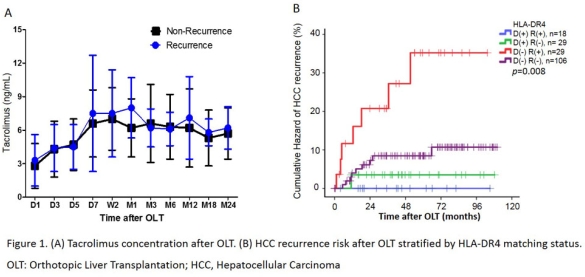HLA-DR4 Matching and Hepatocellular Carcinoma Recurrence after Liver Transplantation
Department of Surgery, Section of Abdominal Transplantation, Washington University School of Medicine, St. Louis, MO.
Meeting: 2018 American Transplant Congress
Abstract number: 546
Keywords: Hepatocellular carcinoma, HLA-DR antigens, Liver transplantation, Recurrence
Session Information
Session Name: Concurrent Session: Liver: Hepatocellular Carcinoma and Other Malignancies
Session Type: Concurrent Session
Date: Tuesday, June 5, 2018
Session Time: 4:30pm-6:00pm
 Presentation Time: 5:06pm-5:18pm
Presentation Time: 5:06pm-5:18pm
Location: Room 6C
PURPOSE: The phenomenon of graft versus host disease after orthotopic liver transplantation (OLT) is estimated at approximately 1-2%, suggesting that under some circumstances, the graft immune system can work against host cells after OLT. Human leukocyte antigen DR4 (HLA-DR4) has been implicated in autoimmune disease and viral recurrence after OLT. This study investigated the role of HLA-DR4 donor/recipient matching in HCC recurrence after OLT. METHODS: We retrospectively reviewed our institutional data of HCC patients with complete donor/recipient HLA typing that included HLA-A, HLA-B, HLA-C, HLA-DR, and HLA-DQ from 1992 to 2014, as well as the serum tacrolimus concentrations up to 24 months after OLT. Patient cumulative hazard of HCC recurrence was stratified by the four HLA-DR4 combinations: donor positive and recipient positive (D(+)R(+)), donor positive and recipient negative (D(+)R(-)), donor negative and recipient positive (D(-)R(+)), and donor negative and recipient negative (D(-)R(-)). The cumulative hazard of HCC recurrence was examined using Kaplan-Meier (KM) analysis. All statistical analyses were performed with IBM SPSS statistics 23. RESULTS: Of the patients underwent OLT in our center for HCC, 182 patients with complete HLA matching information were identified in this study; of these, 17 patients had HCC recurrence after OLT. There was no significant difference in the tacrolimus concentrations between the patients without HCC recurrence and with HCC recurrence. The HCC recurrence proportion of D(+)R(+) was 0%, D(+)R(-) was 3.4%, D(-)R(+) was 29.7%, and D(-)R(-) was 8.1%. Log-rank test in KM analysis demonstrated a remarkable difference in tumor recurrence rate among different HLA-DR4 matching status (p=0.008). CONCLUSION: These results suggest that the HLA-DR4 matching status was associated with different HCC recurrence risk and that the graft immune system could play a role in the response to the tumor cells after liver transplantation. Further clinical and basic studies are required to confirm the findings in this study and explore possible mechanisms. 
CITATION INFORMATION: Xu M., Garcia-Aroz S., Vachharajani N., Lin Y., Chapman W. HLA-DR4 Matching and Hepatocellular Carcinoma Recurrence after Liver Transplantation Am J Transplant. 2017;17 (suppl 3).
To cite this abstract in AMA style:
Xu M, Garcia-Aroz S, Vachharajani N, Lin Y, Chapman W. HLA-DR4 Matching and Hepatocellular Carcinoma Recurrence after Liver Transplantation [abstract]. https://atcmeetingabstracts.com/abstract/hla-dr4-matching-and-hepatocellular-carcinoma-recurrence-after-liver-transplantation/. Accessed January 7, 2026.« Back to 2018 American Transplant Congress
